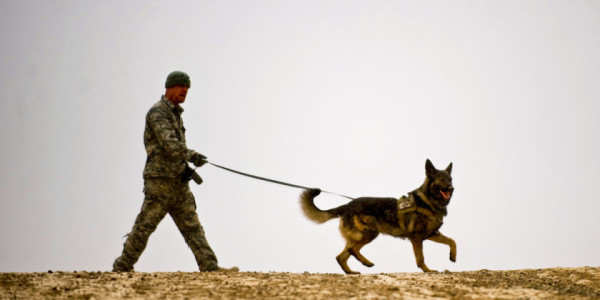

While training your dog can sound daunting, and after trying to convince my own dog that my bed is not in fact, her bed, or that squirrels are not plush chew toys she should eat, I realize that it’s also sometimes frustrating.
But it doesn’t have to be a challenge.
For some dog training tips, Task & Purpose reached out to Mike Dowling, a Marine veteran of the Iraq War, and a former military working dog handler. Dowling also does work with Hounds and Heroes, a nonprofit that provides service dogs to military veterans, and is the author of “Sergeant Rex: The Unbreakable Bond Between a Marine and His Military Working Dog.”
Related: 10 photos that prove the military wouldn’t be the same without its working dogs.
Dowling explained that training actually starts the moment you meet your dog.
“You immediately want to build trust with your dog and be positive with them,” said Dowling, who added that a strong bond between a dog and its owner or handler is an essential pillar in training.
And the foundation is obedience.
“Everything spawns from obedience, because if they won’t sit when you tell them to sit or heel when you to tell them to heel, they won’t do anything else,” said Dowling. “In a human to human relationship they’re equals. In a human to dog relationship you’re the alpha, and that’s important because they rely on you for protection and guidance.”
Additionally, Dowling explained that there’s no set timeline for training your dog.
“It starts when you feel the dog trusts you, and you have a good enough rapport and strong enough bond that they will listen to you, and there’s really no timeframe for it,” said Dowling. “It’s really just dependent on you and your dog.”
If your dog is getting on in years or came to you with a number of bad habits, and you’re worried they’re too ingrained, Dowling insists that the adage “old dogs can’t learn new tricks,” is just that, old and out of date.
“Every dog can learn no matter what age,” said Dowling. “Dogs, like human beings, are continuously learning.”
While it’s one thing to understand the importance of obedience in training, it’s another thing to put into practice.
You need to do three things when training your dog, explained Dowling: Be consistent, positive, and patient.
1. Be consistent
First, you need to find the right place to start training.
“You don’t want to train your dog in your living room, or a public crowded place,” said Dowling. “You want to bring them into an environment where it can be just you and your dog. Whether it’s in a park, or some place where you know you’re going to have limited distractions. Preferably in a fenced in area.”
Once you’ve found the right spot, you need to return there so your dog comes to understand that this is where you go to train.
“When you go there every day, or every other day the dog is going to understand that in that area, it’s time to train,” said Dowling, but adds that it can’t feel like a chore for your dog, he or she has to enjoy it.
2. Keep it positive
When you enter the training area, you should start off by letting your dog run around and play, you know, be a dog.
“You enter the area in a really lighthearted way and let them run around and be a dog,” said Dowling. “Then you slowly and gradually bring them into the training.”
One of the ways to keep it light, is to find out what your dog wants.
“To keep it positive, you find out what your dog likes as a reward, whether it’s a kong or a toy,” said Dowling, who adds that he would discourage food, because if you run out of treats, not only are you not rewarding good behavior, you’re not being consistent.
You also need to end the training session the way you started, on a good note.
“When you leave the training session, make sure you end on a totally positive note.”
Dowling explained that you should “never ever end on a negative note,” because it undermines the work you’ve been doing with your dog, and could cause him or her to be become anxious or confused.
Which leads us to the last tip.
3. Be patient.
The worst thing you can do is to lose your cool or take a bad day out on your dog, explained Dowling, which is why patience is so important.
“Don’t overreact or take it out on them,” said Dowling. “It’s just going to cause stress or anxiety and that can develop into worse things down the line.”
Training your dog is going to be gradual, and isn’t going to happen overnight.
“It’s going to take you a while for your dog to learn,” said Dowling. “Some will learn quick, some will learn slow, but if you’re consistent in rewarding them and how you give them commands and what your expectations are of them, then your dog will eventually pick that up, whether it’s within days, weeks or a month, whatever it is.”
Ultimately, your dog will learn so long as you remain consistent, patient, and positive, because really, all they want is to please you.
“Dog’s like to have a purpose, they want to please their handler, they want to please their owner, but really above all of that, what they really want is your love and affection,” said Dowling.
“In a lot of ways a dog-human relationship is like a human-human relationship but with less words,” said Dowling. “The only key difference is that you want to make them feel like they’re part of the pack.”
If you’re patient and consistent with your dog, he or she will eventually learn, said Dowling
Mike Dowling explains the powerful bond between handlers and their military working dogs in the video below.
